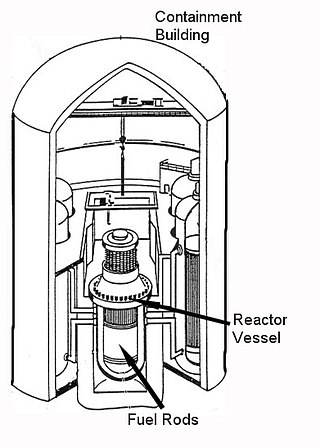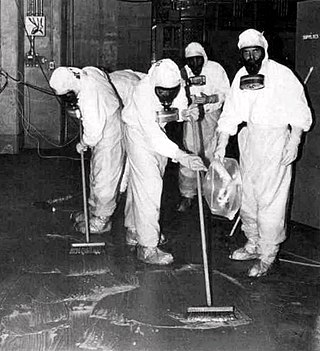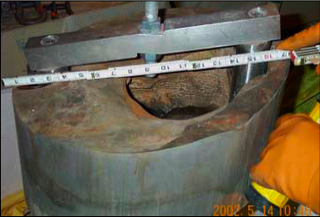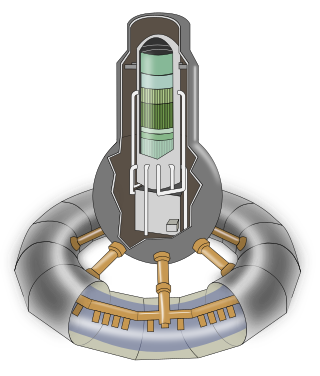Related Research Articles

A boiling water reactor (BWR) is a type of light water nuclear reactor used for the generation of electrical power. It is the second most common type of electricity-generating nuclear reactor after the pressurized water reactor (PWR), which is also a type of light water nuclear reactor.

A nuclear meltdown is a severe nuclear reactor accident that results in core damage from overheating. The term nuclear meltdown is not officially defined by the International Atomic Energy Agency or by the United States Nuclear Regulatory Commission. It has been defined to mean the accidental melting of the core of a nuclear reactor, however, and is in common usage a reference to the core's either complete or partial collapse.

The United States Nuclear Regulatory Commission (NRC) is an independent agency of the United States government tasked with protecting public health and safety related to nuclear energy. Established by the Energy Reorganization Act of 1974, the NRC began operations on January 19, 1975, as one of two successor agencies to the United States Atomic Energy Commission. Its functions include overseeing reactor safety and security, administering reactor licensing and renewal, licensing radioactive materials, radionuclide safety, and managing the storage, security, recycling, and disposal of spent fuel.

A containment building is a reinforced steel, concrete or lead structure enclosing a nuclear reactor. It is designed, in any emergency, to contain the escape of radioactive steam or gas to a maximum pressure in the range of 275 to 550 kPa. The containment is the fourth and final barrier to radioactive release, the first being the fuel ceramic itself, the second being the metal fuel cladding tubes, the third being the reactor vessel and coolant system.

The advanced boiling water reactor (ABWR) is a Generation III boiling water reactor. The ABWR is currently offered by GE Hitachi Nuclear Energy (GEH) and Toshiba. The ABWR generates electrical power by using steam to power a turbine connected to a generator; the steam is boiled from water using heat generated by fission reactions within nuclear fuel. Kashiwazaki-Kariwa unit 6 is considered the first Generation III reactor in the world.

The Economic Simplified Boiling Water Reactor (ESBWR) is a passively safe generation III+ reactor design derived from its predecessor, the Simplified Boiling Water Reactor (SBWR) and from the Advanced Boiling Water Reactor (ABWR). All are designs by GE Hitachi Nuclear Energy (GEH), and are based on previous Boiling Water Reactor designs.

In the United States, nuclear power is provided by 92 commercial reactors with a net capacity of 94.7 gigawatts (GW), with 61 pressurized water reactors and 31 boiling water reactors. In 2019, they produced a total of 809.41 terawatt-hours of electricity, which accounted for 20% of the nation's total electric energy generation. In 2018, nuclear comprised nearly 50 percent of US emission-free energy generation.

Nuclear safety is defined by the International Atomic Energy Agency (IAEA) as "The achievement of proper operating conditions, prevention of accidents or mitigation of accident consequences, resulting in protection of workers, the public and the environment from undue radiation hazards". The IAEA defines nuclear security as "The prevention and detection of and response to, theft, sabotage, unauthorized access, illegal transfer or other malicious acts involving nuclear materials, other radioactive substances or their associated facilities".

Nuclear safety in the United States is governed by federal regulations issued by the Nuclear Regulatory Commission (NRC). The NRC regulates all nuclear plants and materials in the United States except for nuclear plants and materials controlled by the U.S. government, as well those powering naval vessels.

The Fukushima Daiichi Nuclear Power Plant is a disabled nuclear power plant located on a 3.5-square-kilometre (860-acre) site in the towns of Ōkuma and Futaba in Fukushima Prefecture, Japan. The plant suffered major damage from the magnitude 9.1 earthquake and tsunami that hit Japan on March 11, 2011. The chain of events caused radiation leaks and permanently damaged several of its reactors, making them impossible to restart. The working reactors were not restarted after the events.
Core damage frequency (CDF) is a term used in probabilistic risk assessment (PRA) that indicates the likelihood of an accident that would cause severe damage to a nuclear fuel in a nuclear reactor core. Core damage accidents are considered extremely serious because severe damage to the fuel in the core prevents adequate heat removal or even safe shutdown, which can lead to a nuclear meltdown. Some sources on CDF consider core damage and core meltdown to be the same thing, and different methods of measurement are used between industries and nations, so the primary value of the CDF number is in managing the risk of core accidents within a system and not necessarily to provide large-scale statistics.
The three primary objectives of nuclear reactor safety systems as defined by the U.S. Nuclear Regulatory Commission are to shut down the reactor, maintain it in a shutdown condition and prevent the release of radioactive material.

Joseph Mallam Hendrie was an American physicist who was chairman of the U.S. Nuclear Regulatory Commission (NRC). On August 9, 1977 he was named to a four-year term on the Commission and designated as its chairman by President Jimmy Carter. From 1975 to 1977, Hendrie had served as chairman of the Department of Applied Science at Brookhaven National Laboratory.

The United States Government Accountability Office reported more than 150 incidents from 2001 to 2006 of nuclear plants not performing within acceptable safety guidelines. According to a 2010 survey of energy accidents, there have been at least 56 accidents at nuclear reactors in the United States. The most serious of these was the Three Mile Island accident in 1979. Davis-Besse Nuclear Power Plant has been the source of two of the top five most dangerous nuclear incidents in the United States since 1979. Relatively few accidents have involved fatalities.
Arnold "Arnie" Gundersen is a former nuclear industry executive, and engineer with more than 44 years of nuclear industry experience who became a whistleblower in 1990. Gundersen has written dozens of expert reports for nongovernment organizations and the state of Vermont. Gunderson was a licensed reactor operator from 1971-1972 on Rensselaer Polytechnic Institute's zero-power open-pool university research reactor at the Reactor Critical Facility in Schenectady, New York, where he was a nuclear engineering graduate student.
Boiling water reactor safety systems are nuclear safety systems constructed within boiling water reactors in order to prevent or mitigate environmental and health hazards in the event of accident or natural disaster.

The Fukushima nuclear accident was a major nuclear accident at the Fukushima Daiichi nuclear power plant in Ōkuma, Fukushima, Japan which began on 11 March 2011. The proximate cause of the accident was the 2011 Tōhoku earthquake and tsunami, which resulted in electrical grid failure and damaged nearly all of the power plant's backup energy sources. The subsequent inability to sufficiently cool reactors after shutdown compromised containment and resulted in the release of radioactive contaminants into the surrounding environment. The accident was rated seven on the INES by NISA, following a report by the JNES. It is regarded as the worst nuclear incident since the Chernobyl disaster in 1986, which was also rated a seven on the INES.
David A. Lochbaum was the Director of the Nuclear Safety Project for the Union of Concerned Scientists (UCS). A nuclear engineer by training, he worked in nuclear power plants for nearly two decades. Lochbaum has written numerous articles and reports on various aspects of nuclear safety and published two books.

The Fukushima Daiichi reactor, was 1 out of 4 reactors seriously affected during the Fukushima Daiichi nuclear disaster on 11 March 2011. Overall, the plant had 6 separate boiling water reactors originally designed by General Electric (GE), and maintained by the Tokyo Electric Power Company (TEPCO). At the time of the earthquake, Reactor 4 had been de-fueled while 5 and 6 were in cold shutdown for planned maintenance.

General Electric's BWR product line of boiling water reactors represents the designs of a relatively large (~18%) percentage of the commercial fission reactors around the world.
References
- ↑ The San Jose Three
- ↑ The Struggle over Nuclear Power
- ↑ ABC News. "Fukushima: Mark 1 Nuclear Reactor Design Caused GE Scientist To Quit In Protest". ABC News . Retrieved 15 March 2011.